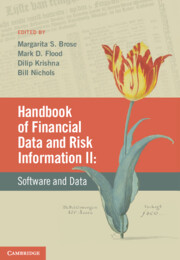Book contents
- Frontmatter
- Contents
- List of contributors
- Preface
- VOLUME II: SOFTWARE AND DATA
- PART IV DATA OPERATIONS IN FINANCIAL INSTITUTIONS
- 15 Financial market participants
- 16 Functional model for financial data and risk information
- 17 Financial institutions' data requirements
- 18 US residential-mortgage transfer systems: a data-management crisis
- PART V DATA MANAGEMENT TECHNOLOGIES
- PART VI IMPLEMENTATION OF DATA AND ANALYTICS PROGRAMS
- Index – Volume II
- References
15 - Financial market participants
from PART IV - DATA OPERATIONS IN FINANCIAL INSTITUTIONS
- Frontmatter
- Contents
- List of contributors
- Preface
- VOLUME II: SOFTWARE AND DATA
- PART IV DATA OPERATIONS IN FINANCIAL INSTITUTIONS
- 15 Financial market participants
- 16 Functional model for financial data and risk information
- 17 Financial institutions' data requirements
- 18 US residential-mortgage transfer systems: a data-management crisis
- PART V DATA MANAGEMENT TECHNOLOGIES
- PART VI IMPLEMENTATION OF DATA AND ANALYTICS PROGRAMS
- Index – Volume II
- References
Summary
Interactions of institutions in the financial industry
There are many unique financial institutions in the USA, with each fulfilling a specific role in financial transactions. Information providers, financial intermediaries, buy-side and sell-side firms, commercial banks, Government Sponsored Entities (GSEs), and regulators, all interact with one another to form the complex web that is the financial industry today (see Figure 15.1). Broker-dealers, Investment Banks, Commercial Banks and Asset Managers transact their own and their clients' business in the financial services markets. Custodians, Agents, Exchanges and Depositories perform diverse functions throughout the financial industry.
Maintaining a fluid transactional system requires institutions to communicate with one another using the same or similar data types. Both investors and regulators need to understand the data provided to them in transactions. The best way to accomplish this is through the use of industry-wide standards for data capture and reporting. Unfortunately, this does not exist in most cases; data collection methods are diverse, and processing the sheer amount of data available is difficult – if not impossible – for most individual investors. For example, classes of derivatives are often mislabeled as other instrument types. This throws off the data stream, and makes for bad data collection.
- Type
- Chapter
- Information
- Handbook of Financial Data and Risk Information IISoftware and Data, pp. 7 - 32Publisher: Cambridge University PressPrint publication year: 2014



